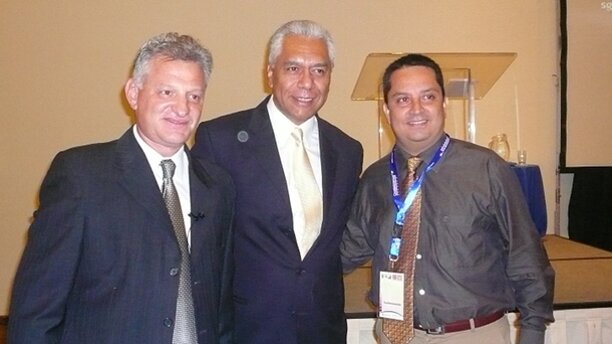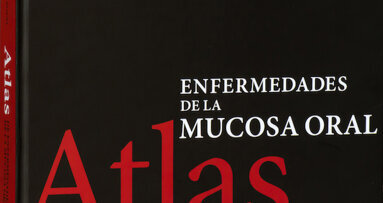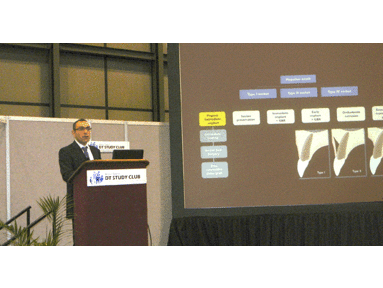PUERTO VALLARTA, MEXICO. It was Dr. Sergio Kohen's first time at an event of the Ibero-Latin American Dental Federation (FDILA), which invited him as a speaker to the "A smile for Haiti" congress. Dr. Kohen traveled all the way from Argentina and said it was very impressed with the quality and attendance to FDILA conferences.
Dr. Kohen is Professor of Dentistry at the University of Buenos Aires Dental School, and author of several books, including a practical and well illustrated atlas on several of issues of greatest interest in dentistry: color, aesthetics and whitening.
Entitled "Color, aesthetics and whitening: Atlas of procedures and techniques" and divided into 13 chapters, the book offers a multidisciplinary approach to these three areas. It comes with a CD containing a PowerPoint document to explain to patients the techniques and results of whitening, and with various customizable forms on informed consent, diet to follow, diagnostic evaluation form, etc.
The chapter on color explains how to understand the transmission of light, while the chapter on aesthetic focuses on veneers, and then he goes on to discuss the diagnosis of stains and pigmentation spots, types of internal and external whitening in the office or at home, and the influence of whitening on dental tissues and materials.
In addition, the book also explains the psychological and psychoanalytic aspects of whitening, offers advice on the marketing of aesthetics and even discusses legal issues in cosmetic dentistry where the practitioner has to reach an agreement with the patient when the treatment does not meet his or her expectations.
The Correct Diagnosis
An entire chapter is devoted to sensitivity, "which is one of the most currend issues," says Dr. Kohen, who gave a lecture in Puerto Vallarta on this issue.
"This is a didactic work, but I think it offers a profound approach to the issue of color and whitening, based on scientific evidence and the literature that supports each technique," he continues.
The Argentine specialist said that, as in other areas of medicine, the basic requirement for whitening is to make the correct diagnosis.
"Since cases are very different, you have to be trained on how color behaves, which is appreciated in the photographs of the cases in the book," he adds. "We must understand that it is not the same thing tetracycline fluorosis that age spots, or sulfur internal bleaching. In other words, we must diagnose the case to determine which technique to apply in every case."
Dr. Kohen said the current dental practice often does not follow this basic rule which is to, first diagnose, second, choose the technique to be used to solve a problem and, finally, decide the most suitable product for it.
Moreover, the specialist said that the media provide aesthetic parameters that in many cases lead adolescents to demand whitening treatments, and that the trigger can be an upcoming event like a wedding, a party, or a trip, while on the other side are patients under dental treatment seeking to improve their appearance or their self-esteem, especially by a whitening treatment.
"The approach is different in each case," continues Dr. Kohen, "for he who comes for a whitening treatment for an upcoming event is different than a regular patien who decides to improve his or her through comestic dentistry."
Changes in the practice
The specialist agrees that the practice has changed a lot, but explains that the same has happened to society, where 20 years ago almost nobody had a computer or internet, much less a cell phone. Globalization has produced a better understanding of cosmetic techniques and larger demand.
"We went from a treating predominantly dental trauma to the era of prevention, with the advent of techniques that allow early treatment, and then to aesthetics, where people lost the fear to the dentist and demand an implant where it lacks a piece, venners or whitening treatment to improve their appearance," he explains.
Kohen says that the practice must take seriously cometic dentistry by getting adequate training to perform these treatments.
First, because often the patient does not get the expected result in cases such as whitenings, andis frustrated, and also because it can result in defective restorations or mucosal lesions that cause a more serious problem.
Dr. Kohen's book offers just that: a guide based on the scientific evidence for diagnostic and clinical procedures in cosmetic dentistry.
Resources
• www.esteticadentalkohen.com.ar
Las Newsletters de Dental Tribune, donde aparecen éste y otros artículos, ofrecen contenido exclusivo para suscriptores y también artículos de acceso ...
Tres grandes figuras de la implantología española e internacional, como son Miguel Peñarrocha, Alberto Fernández y David Peñarrocha, han escrito un ...
Tres grandes figuras de la implantología internacional han escrito “Atlas de implantes cigomáticos”, un libro fundamental para conocer conocer y ...
El profesor Adolfo Arthur Nouel, reconocido experto en problemas de la boca y de la piel, publicó recientemente el libro titulado "Atlas de ...
PUERTO VALLARTA, MÉXICO — El Dr. Sergio Kohen (Argentina), uno de los conferencistas del congreso "Una sonrisa por Haití", ...
Obtain practical continuing education you can use immediately in your implant practice at AAID's Annual Meeting, October 19 - 22, 2011 in exciting Las ...
Un webinar de Dental Tribune te indica cómo evitar los dolores musculoesqueléticos que padecen el 75% de los profesionales de la odontología, a lo que ...
Las investigaciones indican que el 75% de los profesionales dentales sufren de dolor musculoesquelético, a lo que ahora se suma estrés causado por la ...
Moacyr Ely Menéndez nos explica en este segundo artículo las fórmulas de liderazgo avanzado a nivel cerebral que sirven para generar un alto rendimiento ...
NEW YORK — The third day of lectures of the Dental Tribune Study Club Symposia introduced on Tuesday a good variety of speakers and topics at the ...
Webinars en vivo
mié. 14 de enero 2026
11:00 CST (Mexico City)
Dr. Théo Laplane, Dr. Robert Gottlander DDS
Webinars en vivo
vie. 16 de enero 2026
11:00 CST (Mexico City)
Webinars en vivo
lun. 19 de enero 2026
12:00 CST (Mexico City)
Philipp Kopp, Michael Seeber
Webinars en vivo
jue. 22 de enero 2026
8:00 CST (Mexico City)
Prof. Judith Jones D.D.S; M.P.H., Prof. Kakuhiro Fukai D.D.S., Ph.D, Dr. Bathsheba (Bethy) Turton
Webinars en vivo
jue. 22 de enero 2026
13:00 CST (Mexico City)
Dr. Nicola M. Grande DDS, PhD
Webinars en vivo
mié. 28 de enero 2026
7:00 CST (Mexico City)
Webinars en vivo
mié. 28 de enero 2026
10:00 CST (Mexico City)
Prof. Dr. Jan-Frederik Güth



 Austria / Österreich
Austria / Österreich
 Bosnia y Herzegovina / Босна и Херцеговина
Bosnia y Herzegovina / Босна и Херцеговина
 Bulgaria / България
Bulgaria / България
 Croacia / Hrvatska
Croacia / Hrvatska
 República Checa y Eslovaquia / Česká republika & Slovensko
República Checa y Eslovaquia / Česká republika & Slovensko
 Francia / France
Francia / France
 Alemania / Deutschland
Alemania / Deutschland
 Grecia / ΕΛΛΑΔΑ
Grecia / ΕΛΛΑΔΑ
 Hungría / Hungary
Hungría / Hungary
 Italia / Italia
Italia / Italia
 Países Bajos / Nederland
Países Bajos / Nederland
 Nórdico / Nordic
Nórdico / Nordic
 Polonia / Polska
Polonia / Polska
 Portugal / Portugal
Portugal / Portugal
 Rumania y Moldavia / România & Moldova
Rumania y Moldavia / România & Moldova
 Eslovenia / Slovenija
Eslovenia / Slovenija
 Serbia & Montenegro / Србија и Црна Гора
Serbia & Montenegro / Србија и Црна Гора
 España / España
España / España
 Suiza / Schweiz
Suiza / Schweiz
 Turquía / Türkiye
Turquía / Türkiye
 Reino Unido e Irlanda / UK & Ireland
Reino Unido e Irlanda / UK & Ireland
 Internacional / International
Internacional / International
 Brasil / Brasil
Brasil / Brasil
 Canadá / Canada
Canadá / Canada
 EE UU / USA
EE UU / USA
 China / 中国
China / 中国
 India / भारत गणराज्य
India / भारत गणराज्य
 Paquistán / Pākistān
Paquistán / Pākistān
 Vietnam / Việt Nam
Vietnam / Việt Nam
 Asean / ASEAN
Asean / ASEAN
 Israel / מְדִינַת יִשְׂרָאֵל
Israel / מְדִינַת יִשְׂרָאֵל
 Argelia, Marruecos y Túnez / الجزائر والمغرب وتونس
Argelia, Marruecos y Túnez / الجزائر والمغرب وتونس
 Oriente Medio / Middle East
Oriente Medio / Middle East



































































To post a reply please login or register